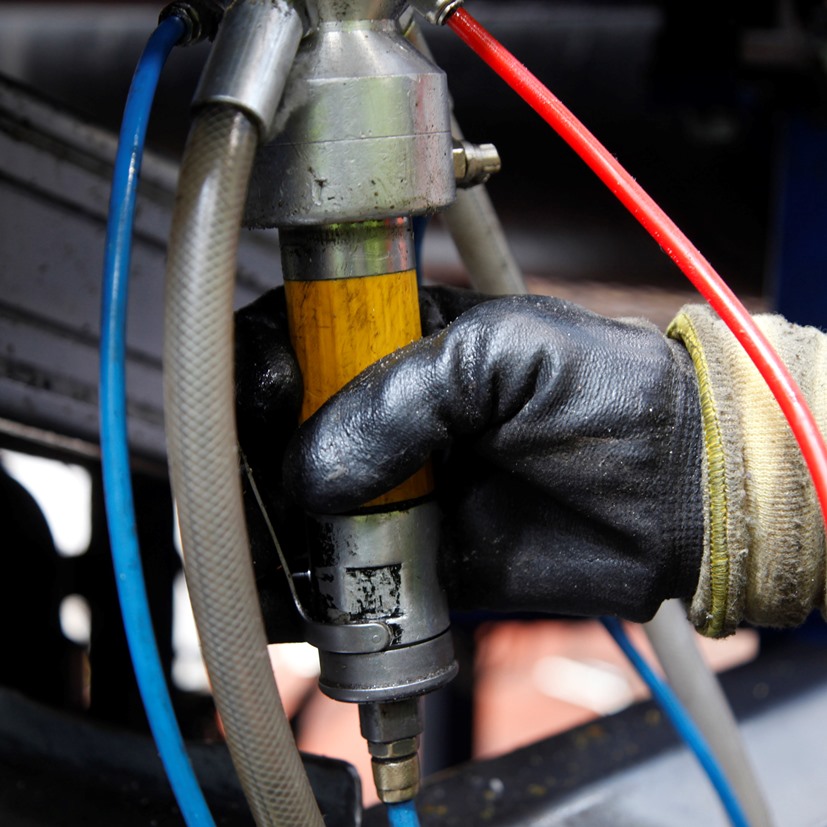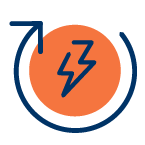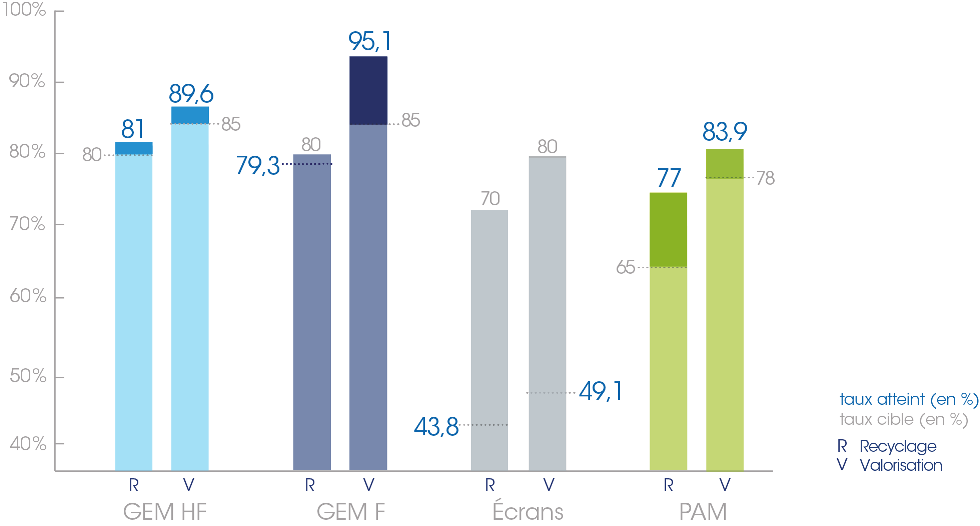Everything about logistics and treatment in 2018.


76.6%
average recycling rate in 2018

85.6%
average recovery rate in 2018

73
treatment centres

345
audits and control visits

|
|
Recycling
|
Target rate
|
Recovery
|
Target rate
|
|---|---|---|---|---|
| Cat. 1 | 80.32% | 80% | 90.51% | 85% |
| Cat. 2 | 77.02% | 55% | 83.89% | 75% |
| Cat. 3 | 71.88% | 70% | 78.51% | 80% |
| Cat. 4 | 55.31% | 70% | 61.18% | 80% |
| Cat. 6 | 77.00% | 55% | 83.86% | 75% |
| Cat. 7 | 77.00% | 55% | 83.86% | 75% |
| Cat. 8 | 77.00% | 55% | 83.86% | 75% |
| Cat. 9 | 77.00% | 55% | 83.86% | 75% |
|
Products obtained from treatment
|
Tonnes
|
|
|
|
|---|---|
| Electrical cables | 8,324.47 |
| Printed circuit boards | 8,347.58 |
| Toner cartridges | 207.15 |
| CFCs, HCFCs, HFCs and HCs: gases extracted in the first depollution phase | 99.90 |
| CFCs, HCFCs, HFCs and HCs: gases extracted in the second depollution phase | 331.61 |
| CFCs, HCFCs, HFCs and HCs: oils containing traces of CFCs | 359.61 |
| Components containing refractory ceramic fibres | 0.00 |
| Components containing radioactive substances | 0.01 |
| Components containing mercury | 0.70 |
| Capacitors containing polychlorobiphenyl (PCB) and electrolytic capacitors containing hazardous substances | 308.80 |
| Asbestos waste and components containing asbestos | 0.00 |
| LCD monitors and backlit gas discharge lamp monitors | 8,138.67 |
| Gas discharge lamps | 77.95 |
| Plastics containing brominated flame retardants | 13,203.07 |
| Batteries and accumulators | 896.39 |
| Cathode ray tubes | 24,403.18 |
ESR has published its new environmental indicators! These indicators are the result of several years of work to collect, analyse and process field date on operational activities managed by ESR (WEEE collection logistics, processing, etc.). Given their relevancy for the activities managed by ESR, three environmental indicators have been retained:
For each indicator, three vales are given:
The net balance, i.e. the difference between these benefits and impacts.
For each indicator the net balance gives a measure of the environmental added-value of operations managed by ESR through the regeneration of materials and energy production.
The benefits of cooling and expansion gases pollution removal are evaluated in a clear way. In 2018, removing this pollution allowed the equivalent of 1,758,583 t of CO2 emissions to be avoided.
2,207
Redeployment
2,489
Reuse
212,671
Recycling
22,265
Recovery
27,413
Destruction
916
Redeployment
1,064
Reuse
75,647
Recycling
15,148
Recovery
4,653
Destruction
307
Redeployment
26
Reuse
19,880
Recycling
2,423
Recovery
55,043
Destruction
646
Redeployment
13
Reuse
118,803
Recycling
10,587
Recovery
24,906
Destruction

In 2018 ESR launched a major project to redefine its operational processes for all the sectors it addresses. This involves defining a streamlined, comprehensive and coherent service offering for partners and service-providers. This approach is not only fully in line with the spirit of simplification engaged by the merger of Eco-systèmes and Récylum to form ESR, but also with the challenges to be met in order to achieve collection targets.
A new global logistical and treatment system will be implemented with new contracts at the beginning of 2021 for a 3-year period. This system will be accompanied by the integration of all operations within a single information system. Management indicators will also be streamlined.
Much work has to be undertaken on identifying, enhancing and embodying operational synergies in regards to pooling, containers, dematerializing and traceability. Modelling of a target system will then follow for logistical and treatment processes, before moving onto the the implementation of invitations to tender. The provision of assistance to ESR’s partners and service-providers is planned in order to deploy and manage the changes instigated by this new organisation.
The key points in operational processes to be redefined and streamlined, include weighing, container management, management of WTN (waste transfer note), time frames and the management of regulated hazardous substances, undesirable and intrusive waste. These will be carefully studied in order to propose a coherent and unified target system followed by a unique and adapted information system,
This major project of an unparalleled scale is mobilising all of ESR’s services, in all sectors. This provides an excellent opportunity to improve the process and be bold in terms of streamlining and simplification.



Launched in 2014 by Eco-systèmes with the Fondation ParisTech, the purpose of the Urban Mines” Chair is, in particular, to explore new recycling processes for two large families of material: plastics with all the difficulties inherent to these materials and strategic metals that are essential for the production of numerous technological objects.
Organised by the Chimie ParisTech School, the purpose of the symposium held on 5 and 6 June 2018 was to present the works of students involved in this Chair’s studies and to encourage exchanges with representatives in other fields: public authorities, as guarantors of general public interest, and the regulators of the EPR sectors as well as technical representatives of operators, producers, federations and associations, accompanied by scientists and legal experts.
ESR and the Institut Supérieur d’Ingénierie et de Gestion de l’Environment (ISIGE) from MINES ParisTech signed an agreement in 2018 to make formal their cooperation in environmental and sustainable development training. Both partners are planning on emphasising the “Circular Economy” in ISIGE’s Mastère Spécialisé IGE (Masters specialising in environmental management and engineering) by using real cases from different sectors, in particular the electric and electronic equipment sector.
Indeed, the development of a circular economy requires new engineering and management profiles able to act as “architects of the unknown”. ESR is thereby providing ISIGE with its 13 years’ worth of experience in creating and managing an operational system that brings together the sector’s stakeholders. It is also participates in funding the training and from time to time proposes real cases to the students based on realities in the field.
This new cooperation reflects the continuity in the relationship established between ESR and ParisTech within the “Urban Mines” Chair launched in 2014. For ESR, it is crucial to be involved in this dynamic that develops training suited to the stakes and challenges of an economy that is increasingly becoming circular. It is also essential to develop training courses in order to be connected to the current and future needs of environmental and sustainable development professionals.
The agreement is valid for at least three years. Students from the 2018-2019 academic year worked on the topic of plastics and the challenges in recycling these. With the aim of recycling 100% of plastics by 2025, they studied the possible responses from he different stakeholders in a product sector (small household appliances).